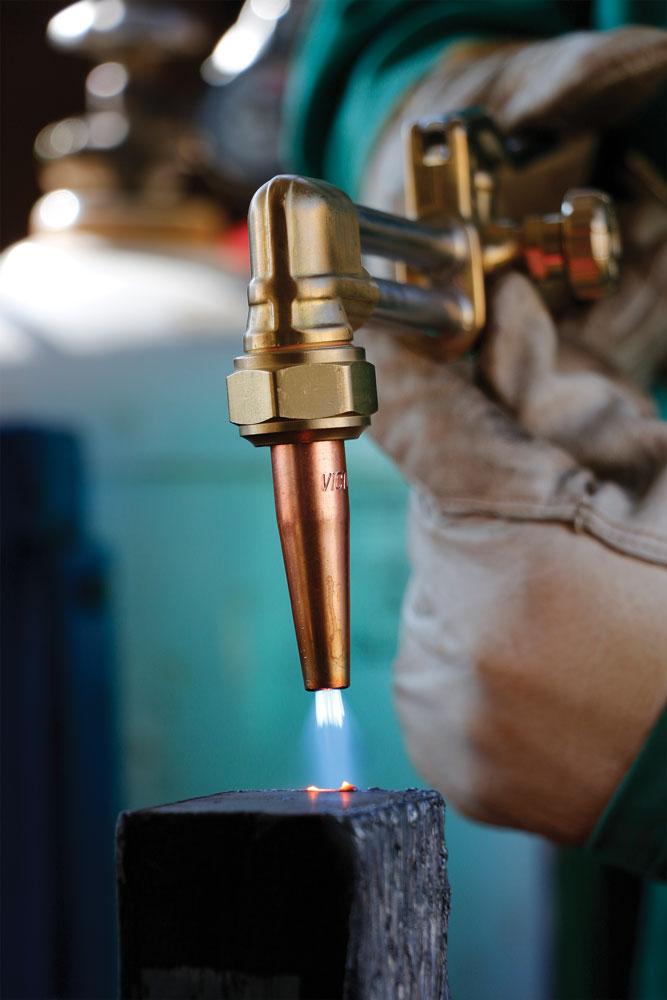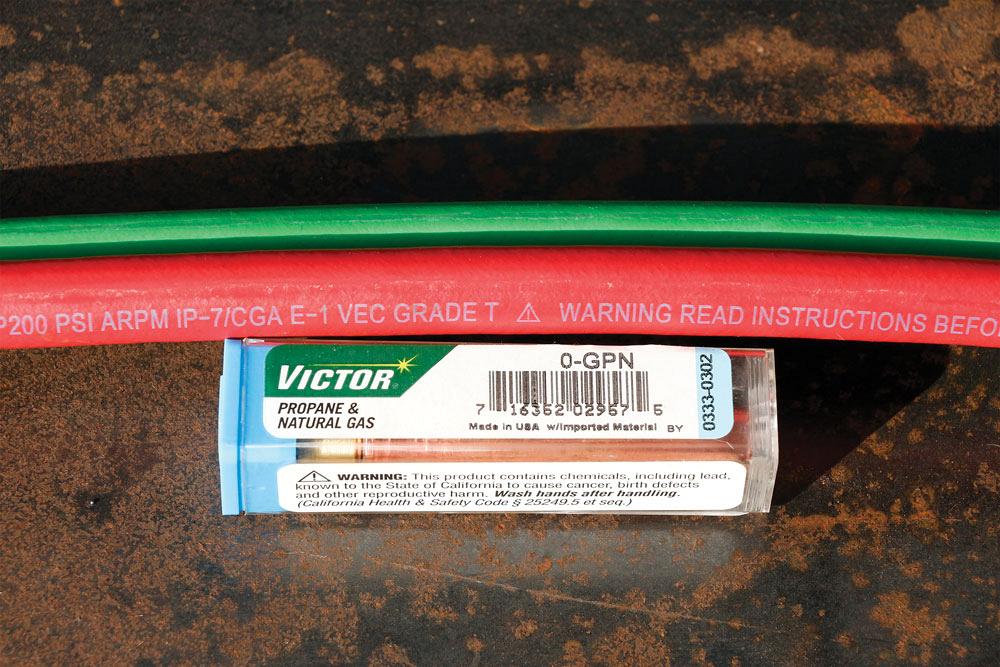Global Product Manager
- FMA
- The Fabricator
- FABTECH
- Canadian Metalworking
Using alternate fuel gases for cutting and heating
Successfully switching from acetylene to fuel gases such as propane and propylene requires a modest equipment change and learning a few new techniques
- By Curt Rocha and John Henderson
- May 1, 2019
- Article
- Welding
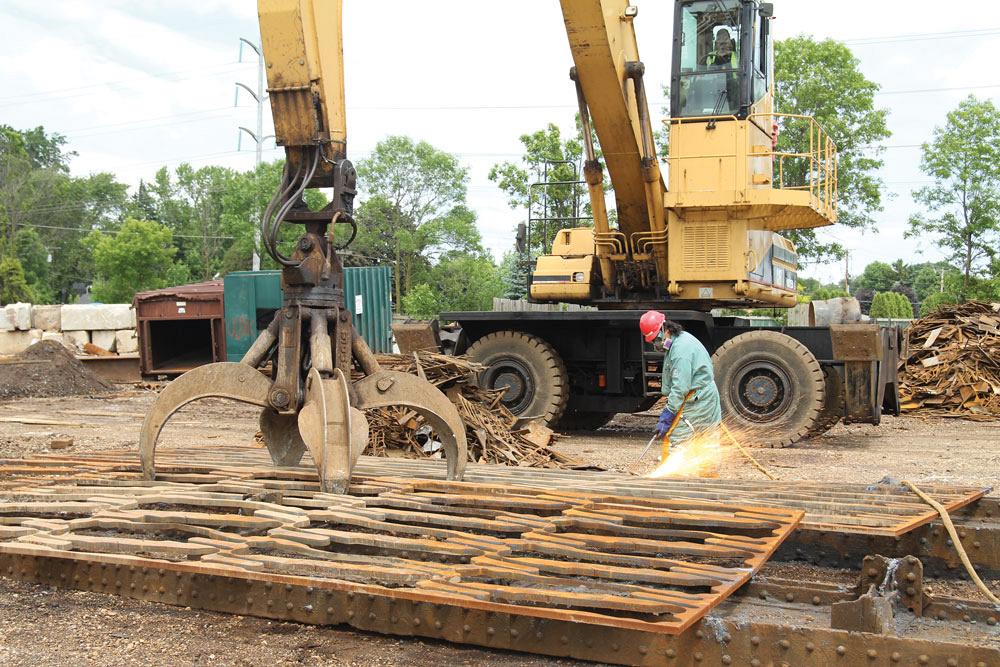
This scrapyard uses low-cost natural gas and an extended cutting torch for better reach and to move the flame farther away from the operator.
Ford vs. Chevy. Canadians vs. Maple Leafs. Acetylene vs. alternate fuels. OK, Montreal dominates the Stanley Cup count, but outside of that, asking what’s the best choice often comes down to a matter of personal preference. Acetylene remains the most popular fuel gas, but users can gain cost, safety, and performance benefits using an alternate fuel such as propane, natural gas, propylene, and proprietary gas blends. However, a number of misconceptions surround alternate fuels. This article sets some of the facts straight, helps operators select the essential equipment (Figure 1), and provides hand-held torch operators with essential tips for success.
Misconception: Alternate Fuels Don’t Work as Well as Acetylene
The source of this misconception stems from the maximum possible neutral flame temperature, which is 5,720 degrees F for acetylene and 5,112 degrees F for propane. (For illustration purposes, this article often uses propane as a representative alternate fuel because of its popularity. Note that propane-based proprietary alternate fuel blends, which have 0.5 per cent additional gases, can burn at 5,800 degrees F.) Because acetylene burns about 10 per cent hotter, people say they can cut faster with it.
However, first, heat is measured in BTUs, and propane has about 1,000 more BTUs per cubic foot of gas than acetylene (as we’ll discuss shortly). Second, remember that oxyfuel cutting is high-speed oxidation, and that the cutting oxygen does the real work. The fuel gas mostly helps preheat the plate. Third, unless you can maintain perfect technique, obtaining every inch of extra speed will be hard, which leads to the fourth point: Performance issues with propane largely stem from improper technique.With acetylene, you hold the tip of the inner cones of the primary flame just off the metal to preheat the plate. That’s because acetylene releases almost 40 per cent of its heat in the primary flame. Conversely, most of the heat in a propane flame is located in the secondary flame, or outer cone. The primary flame releases only about 10 per cent of the heat. For that reason, you should hold the torch about ½-in. off the plate when using an alternate fuel (see Figure 2). Standoff can be reduced during cutting, but effectively bringing the plate to its kindling temperature requires a longer standoff. Failure to do so results in a longer preheat time, a common source of complaints with alternate fuels.
Speaking of heating, alternate fuels outperform acetylene in heating applications because they have a higher thermal output. Because alternate fuels release more of their heat in the secondary flame, they are said to create more of a “soaking” or “quenching” type heat. As an example, when heating a large plate with alternate fuels, you can easily heat the whole plate cherry-red. With acetylene, the starting point will have darkened by the time the torch reaches the end of the plate.
The science behind the numbers shows why. Acetylene produces approximately 1,470 BTUs per cu. ft., and propane produces approximately 2,500 BTUs per cu. ft. With propane, a size 15 multiflame heating attachment can produce about 499,600 BTUs/hr. (200 square cubic feet/hr. fuel consumption x 2,498). With acetylene, a size 15 MFA produces about 324,400 BTUs/hr. (220 SCFH fuel consumption x 1,470).
Given propane’s lower cost, choosing to heat with propane should be a slam-dunk decision. While alternate fuels do require a higher oxygen-to-fuel gas ratio than acetylene (4-to-1 for propane vs. 1.5-to-1 for acetylene), they can lower costs by 40 per cent or more depending on the fuel choice and local pricing.
Misconception: Propane Isn’t Hot Enough for Welding
One misconception is that alternate fuels can’t be used for welding steel because the flame is not hot enough. Considering carbon steel alloys melt between 2,500 and 2,800 degrees F, this isn’t quite inaccurate.
The real reasons are twofold. First, the more concentrated heat of the primary flame is the major factor when gas welding, and propane doesn’t have enough concentrated heat. Second, alternate fuels don’t create any shielding gas when they burn. Conversely, a proper mixture of oxygen and acetylene with a neutral flame produces CO2, which in turn shields the molten weld puddle from atmospheric contamination.
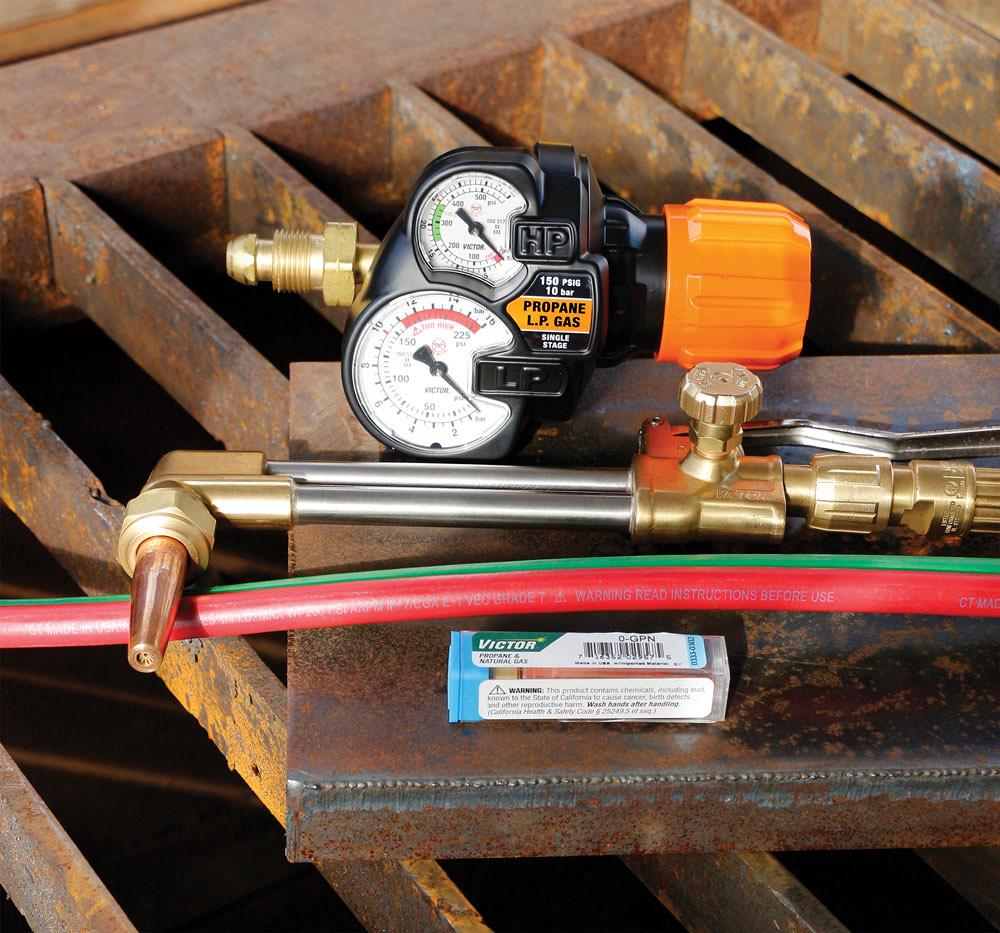
Essential equipment for cutting with alternate fuels includes (top to bottom) a fuel-specific regulator, a cutting attachment with a universal mixer (which works with all fuel gases), Grade T hose, and fuel-specific cutting tips.
Note that propane can be used for brazing, as that process doesn’t require a shielding gas or the concentrated heat necessary in the primary flame.
Misconception: You Need to Use a Different Torch for Alternate Fuels
Cutting torches (and cutting attachments for combination torches) mix fuel gas and oxygen using different technologies. Those with a spiral mixer (also often called an equal pressure mixer) are calibrated to work with both alternative fuel gases (which use lower delivery pressures) and acetylene (which uses slightly higher delivery pressures). These torches keep the gases pressurized and mix them via turbulence between the handle and the torch head.
Other torches feature an injector or venturi style mixer that does not pressurize the fuel gas. The oxygen flow actually siphons the fuel out at the mixing point. Injector torches are fuel-specific, so you will need different torches for acetylene and alternate fuels. They are the best choice for work at 2 pounds per square inch (PSI) and below (using a size 000 tip to cut plate thinner than 1/8 in., a rare occasion).
The most popular torches on the market use a universal gas mixer design that combines the spiral and injector principles. The result is a high-performance torch that operates efficiently on any fuel gas delivered at 2 PSI and above, so there is no need to change torches when switching to alternate fuels.
Here’s the bottom line on mixer design: All of these mixer designs will perform exceptionally well, delivering the maximum flame temperature and combustion intensity. The key is to ensure that the regulators and torch valves are set so that they provide the correct proportions of oxygen and fuel gas to the mixer.
Misconception: Acetylene Regulators Work With Alternate Fuels
Safety standard ANSI Z49.1-2005, Safety in Welding, Cutting and Allied Processes, states that “Pressure reducing regulators shall be used only for the gas and pressures for which they are labeled.” A regulator for use with propane or propylene must be marked “L.P. Gas” to indicate that it can be used with liquefied petroleum fuel gases (see Figure 3).
At pressures over 15 pounds per square inch gauge (PSIG), acetylene is considered unstable and can violently decompose and explode without the presence of a spark or flame. As such, UL and CSA require acetylene regulators to have a 15-PSIG delivery limit and a red band on the gauge above 15 PSIG as a warning. LP gases operate at higher pressures, so an LP gas regulator can be adjusted much higher than 15 PSIG. Even if a regulator could physically deliver the appropriate pressure, using a non-fuel-specific regulator increases the danger of accidentally adjusting above 15 PSIG, which can be extremely hazardous. Don’t do it – EVER! Always use regulators that have been specifically designed and marked for the type of gas they service.
Regulators that are labelled and colour-coded (e.g., red for acetylene, orange for LP/propane, and green for oxygen) for easier identification will help you to select the correct regulator. Regulators for alternate fuels will have a “510” CGA (Compressed Gas Association) connection. Be sure to select a regulator with sufficient capacity for the application, medium-duty, heavy-duty, or high-capacity. If needed, consult with the manufacturer or welding supply distributor when switching regulators.
No Myth Here: Use a Grade T Hose
This is one area where most of the internet gets it right: use a Grade T hose for alternate fuels (Figure 4), as recommended by the CGA and Rubber Manufacturers Association. The neoprene liner of this hose will not allow the liquid phase of an alternate fuel to permeate through it. Grade R and RM hose (the grades sometimes used for acetylene) can potentially allow liquefied gas to permeate through the gas hose and into the oxygen hose.
Fuel Characteristics and Cutting Tips
Each fuel has a different burn rate, or velocity at which the gas burns back toward the torch tip. While a flame may look as if it’s burning away from the torch, the opposite is actually happening. Alternate fuels have slower burn rates than acetylene. Achieving proper flame attachment between the end of the tip and ignition point of the flame requires using tips specifically engineered to accommodate the particular burning rate of the fuel gas.
Manufacturers engineer consumables to match the characteristics of each fuel gas which is why tips have different recesses (Figure 5). Alternate fuel tips with a two-piece design provide the best performance. The burning rate of acetylene creates a natural standoff, so acetylene tips are flat and manufactured as a single piece.
When using alternate fuels, you can address common issues by using different cutting tips. For example, for faster preheat times, replace the general-purpose (GP) tip with a heavier preheat (HP) tip. GP tips have 18 preheat slots versus 22 slots (Figure 6) for an HP tip. The four additional slots allow HP tips to apply more heat to the contact area, enabling alternate fuels to nearly match the preheat time of acetylene. HP tips are fuel-specific; use tips marked HPP for propylene and HPN for natural gas/propane.
In addition, HP tips make lighting the fuel gas easier, which can help when working outdoors or in windy areas. When you are working with high-alloy plate, extremely rusty plate, or when bevelling, HP tips can improve performance. Cutting tip sizes correspond to those used with acetylene. Alternate fuel tips are also available for gouging, rivet washing, and cutting close to bulkheads.
Lighting Procedure
Where acetylene weighs close to the same as air (0.91), alternate fuels have a tendency to float up or sink down. Natural gas is lighter than air (0.55), while propane (1.52) and propylene (1.47) are heavier. Because of these differences, you may need to use different techniques for lighting a torch using alternate fuel.
To light a combination torch, open the oxygen valve on the handle all the way; this ensures maximum oxygen flow to the cutting oxygen lever. Next, turn the fuel gas valve one-quarter and light the torch. Alternate between adding oxygen (via the cutting oxygen valve) and fuel to “walk up” the flame to the desired heat and achieve a neutral flame (more on that shortly).
If wind extinguishes the flame using the first technique, put back pressure on the flame to reduce its burn velocity. After turning the fuel valve one-quarter turn, place the tip on the work surface at a 45-degree angle, light the torch and — holding the torch in place — open the cutting oxygen valve until the flame “snaps” into place (Figure 7). You will hear an actual snap.
The third way to light a torch with alternate fuels is to open the fuel and cutting oxygen valves with a one-quarter turn, light the flame, and walk it up to the desired temperature.
Regardless of fuel gas, always follow the same shutoff procedure: oxygen first, alternate fuel gas last. Shutting of the oxygen first removes the most critical leg of the fire triangle and, after shutting off the fuel valve, lets you check for a fuel gas valve leak. If a small flame remains attached to the torch, it might be time to repair the fuel valve.
Achieving a Neutral Flame
Achieving a neutral flame starts by increasing gas flow to the point where soot discharge disappears (or when the flame achieves a small standoff from the tip) and then adding oxygen until the secondary flames recede to the point where they are even with the primary flames, or the luminous cones at the tip. With alternate fuels, the flame needs to be walked up or forced to prevent starving or extinguishing the flame.
After lighting the torch and adding the initial preheat oxygen, alternatively add more fuel and more oxygen by opening the respective valves one-quarter to one-half turn at a time until the fuel gas valve is completely (or almost completely) open. Then add oxygen until the flame creates a loud whistling sound and the primary cones reach their shortest point. Depress the cutting oxygen lever and readjust the preheat oxygen if necessary.
To check for a neutral flame, place the torch perpendicular to and near the surface of the workpiece. The preheat flames will create a star pattern with clearly defined legs about 2 to 3 in. long (Figure 8). An oxidizing flame will have shorter and sharper legs, whereas a carburizing flame will have longer and more feathery legs.
John Henderson is regional product line manager, 940-381-1440, and Curt Rocha is global product manager, 940-381-1360, ESAB Welding & Cutting Products, 2800 Airport Rd., Denton, TX, 76207, www.esab.com.
About the Authors
John Henderson
Director of Product Development for Gas Equipment
800-426-1888
subscribe now


Keep up to date with the latest news, events, and technology for all things metal from our pair of monthly magazines written specifically for Canadian manufacturers!
Start Your Free Subscription- Trending Articles
BlueForge Alliance partners with Nuts, Bolts & Thingamajigs to develop Submarine Manufacturing Camps

Portable system becomes hot tech in heat treatment

Orbital tube welding webinar to be held April 23

Cidan Machinery Metal Expo 2024 to be held in Georgia May 1-2

Corrosion-inhibiting coating can be peeled off after use
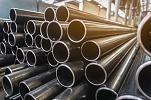
- Industry Events
MME Winnipeg
- April 30, 2024
- Winnipeg, ON Canada
CTMA Economic Uncertainty: Helping You Navigate Windsor Seminar
- April 30, 2024
- Windsor, ON Canada
CTMA Economic Uncertainty: Helping You Navigate Kitchener Seminar
- May 2, 2024
- Kitchener, ON Canada
Automate 2024
- May 6 - 9, 2024
- Chicago, IL
ANCA Open House
- May 7 - 8, 2024
- Wixom, MI













